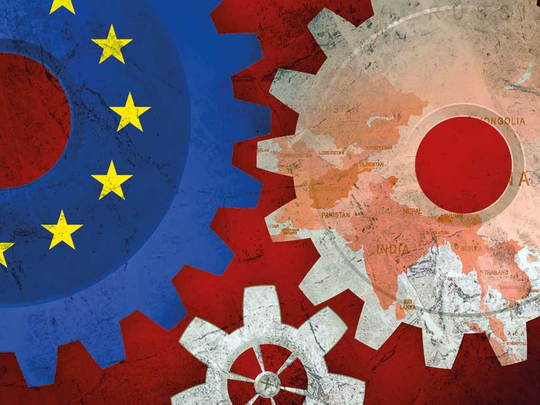
As the two-year anniversary of Donald Trump’s presidential election approaches, key Asia-Pacific and Europe nations are coming closer together. On Friday, the EU-Asia summit finished with more than 50 heads of state and government, including Chinese Premier Li Keqiang, and EU chiefs Donald Tusk and Jean-Claude Juncker, in attendance.
Both sides have strong common political and economic interests, and the summit saw Brussels showcasing a major new initiative, shadowing China’s Belt and Road project, to improve connectivity with the Asia-Pacific region.
The ‘EU strategy on Connecting Europe and Asia’ is a foreign policy plan to enhance transport, energy and digital links which may help make a significant dent in the $26 trillion (Dh95.49 trillion) infrastructure gap cited by the Asian Development Bank.
While there is a clear economic element to this initiative, politics is key too. Not only are some of Donald Trump’s key foreign policies pushing the two continents closer. Brussels also wants to develop a European-centric alternative to China’s massive Belt and Road project, asserted as the biggest initiative of its kind in history with a trillion-dollar price tag.
Common interests
The new EU plan aims to try to bring together sometimes diverse, and competing, European member-state interests toward the Asia-Pacific. Of course, Europe already has multiple common interests across the vast region to its east, which include enhancing regional stability and security in theatres such as the Korean peninsula; and increasing regional cooperation through multilateral forums such as the Asean Regional Forum.
Going forward, the strategic rationale for greater bilateral political, economic, financial, social and cultural connectivity is clear for both Europe and the Asia-Pacific. These regions, collectively, account for around 70 per cent of the world’s population and over 60 per cent of global GDP.
Moreover, the Asia-Pacific accounts for over one-third of EU export markets, and around half of the goods and services imported by Europe come from the Asia-Pacific.
While the new European connectivity plan is, resourcing wise, a pale shadow of China’s $1 trillion Belt and Road, it has the potential nonetheless to make a significant difference going forward. This is because the bilateral relationship increasingly relies on effective, functioning and sustainable connectivity — in other words, on the physical and non-physical infrastructure through which goods, services, ideas and people can flow unhindered. And here it is no coincidence that key European and Asian leaders want a smooth and frictionless ‘rules-based order’, not least in the sphere of international trade and economics where both continents are facing into disruptive spats against the United States. Both sides therefore stressed again this week their support for a multilateral system with the World Trade Organisation (WTO) at its core, and their opposition to US trade protectionism asserting that such unilateral actions risk potentially pushing the global economy into recession.
Sustainable development
Another vital area of shared interest is global warming and sustainable development. One key reason why this is so important in the bilateral dialogue is that, collectively, the EU and China alone account for around one-third of global greenhouse emissions — which grows significantly larger when the rest of the Asia Pacific is added into the picture.
Especially after this month’s hard-hitting UN report on the growing risks of global warming, strong, bold climate leadership by the Asia-Pacific and Europe is therefore especially important to preserve the integrity of the Paris accord following Trump’s decision to pull the United States out of it. An overriding reason why EU-Asia-Pacific discussions on global warming are generally so cooperative is that, fundamentally, both sides share a vision of a prosperous, energy-secure future in a stable climate.
With appropriation vision, both sets of leaders recognise that there is a massive ‘win-win’ opportunity on the horizon from accelerating the transition to a low carbon future. And bilateral collaboration in this area looks set to only deepen going forward.
The scale of China’s and the wider Asia-Pacific’s planned investment in the green economy is staggering, a fact that the EU is increasingly recognising. Here, Asia-Pacific countries are proving open to learn from Europe’s extensive experience.
Especially having pioneered the EU Emissions Climate Trading System, the world’s first major carbon market, Europe has clear strengths in this area that the Asia-Pacific could harness. And there are thus substantial commercial opportunities for EU-based technology and science firms, which are leaders on much of this clean technology agenda.
Yet, this collaboration may increasingly not just be one-way traffic. Indeed, some Asia-Pacific countries, especially China, are becoming very large investors in renewable energy, and it is increasingly possible that technology transfer will be a two-way process.
Cooperation could build low carbon industries in a range of sectors, and also align Europe more closely to many of the world’s fastest-growing economies.
Taken overall, both European and Asia-Pacific leaders are increasingly recognising that they have much to potentially gain from a deeper partnership. With Trump challenging the rules-based order, now is thus the time for both parties to intensify cooperation to bolster economic growth and political ties to deepen their global partnership into the 2020s on issues from climate change to international trade.
Andrew Hammond is an associate at LSE IDEAS at the London School of Economics.







